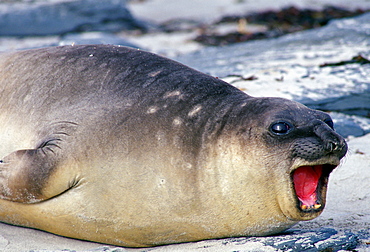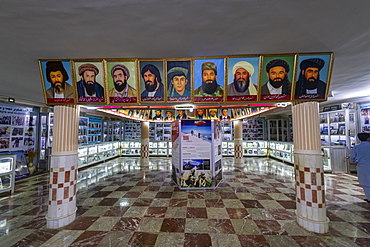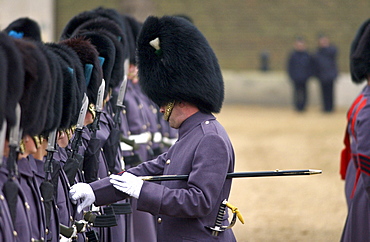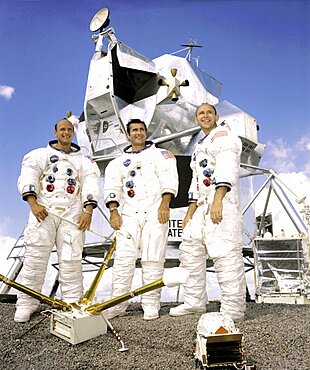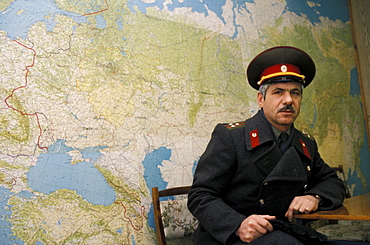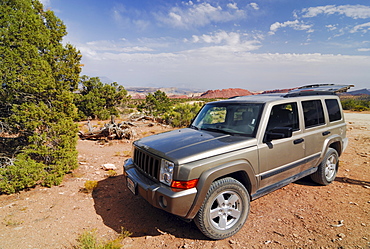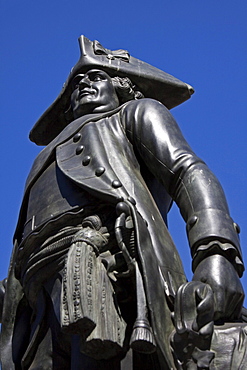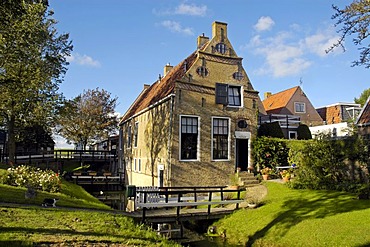Results
13 results found
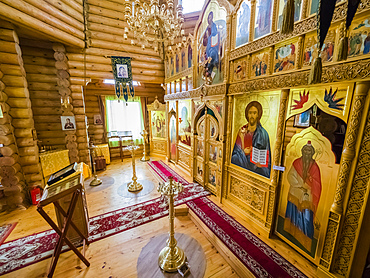
Interior view of the Russian Orthodox Church in Nikolskoye Village, Commander Islands, Kamchatka, Russia, Eurasia
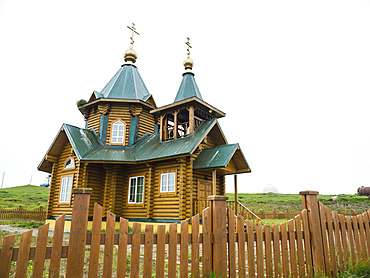
Exterior view of the Russian Orthodox Church in Nikolskoye Village, Commander Islands, Kamchatka, Russia, Eurasia
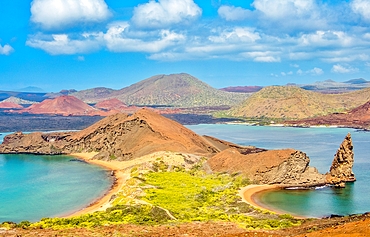
Bartolome Island with Pinnacle Rock, a volcanic plug, to the right, the location featured in the 2003 film Master and Commander, Galapagos islands, UNESCO World Heritage Site, Ecuador, South America

Bas relief of the commander of the vanguard riding an elephant and the army of King Suryavarman II at Angkor Wat, UNESCO World Heritage Site, Siem Reap, Cambodia, Indochina, Southeast Asia, Asia
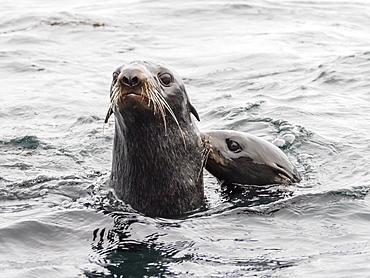
Northern fur seals (Callorhinus ursinus), Bering Island, Commander Island Group, Kamchatka, Russia, Eurasia
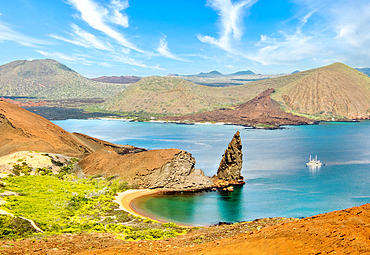
Bartolome Island with Pinnacle Rock, a volcanic plug, to the right, a location in the 2003 film Master and Commander, Galapagos Islands, UNESCO World Heritage Site, Ecuador, South America
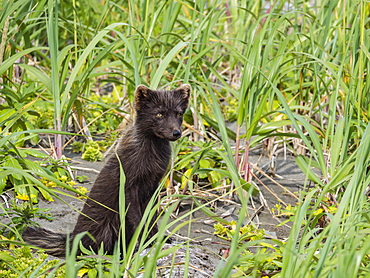
Adult Arctic fox (Vulpes lagopus), in summer brown fur coat on Bering Island, Commander Islands, Kamchatka, Russia, Eurasia

Statue by Tom Murphy, of Captain Frederick John Walker, noted World War II British Royal Navy officer, anti-submarine warfare commander and namesake for the whisky, near Albert Dock, Liverpool, Merseyside, England, United Kingdom, Europe
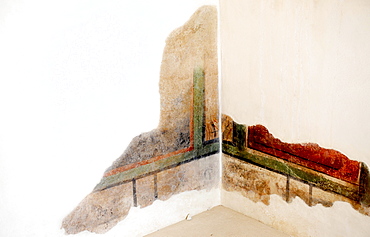
Remains of frescoes in the office of the commander, Masada National Park, Judea, Israel, Middle East, Southwest Asia

Residence of the commander, Masada National Park, Judea, Dead Sea, Israel, Middle East, Southwest Asia

Kommandantenhaus or commander's house, Bergfeste Dilsberg castle, Dilsberg district, Neckargemuend, Naturpark Neckar-Odenwald nature park, Odenwald, Baden-Wuerttemberg, Germany, Europe
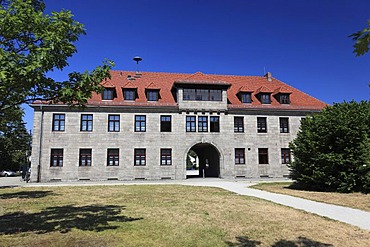
Commander's Gate at the entrance to the Flossenbuerg Concentration Camp Memorial, district of Neustadt an der Waldnaab, Upper Palatinate, Bavaria, Germany, Europe
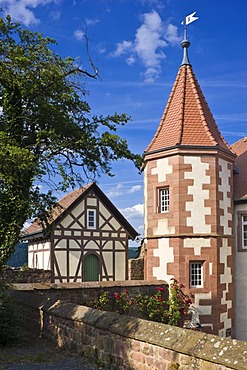
Kommandantenhaus or commander's house, Bergfeste Dilsberg castle, Dilsberg district, Neckargemuend, Naturpark Neckar-Odenwald nature park, Odenwald, Baden-Wuerttemberg, Germany, Europe

Commander's Gate at the entrance to the Flossenbuerg Concentration Camp Memorial, district of Neustadt an der Waldnaab, Upper Palatinate, Bavaria, Germany, Europe
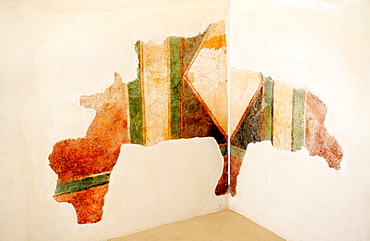
Remains of frescoes in the office of the commander, Masada National Park, Judea, Israel, Middle East, Southwest Asia

Kommandantenhaus or commander's house, Bergfeste Dilsberg castle, Dilsberg district, Neckargemuend, Naturpark Neckar-Odenwald nature park, Odenwald, Baden-Wuerttemberg, Germany, Europe

Kommandantenhaus or commander's house, Bergfeste Dilsberg castle, Dilsberg district, Neckargemuend, Naturpark Neckar-Odenwald nature park, Odenwald, Baden-Wuerttemberg, Germany, Europe
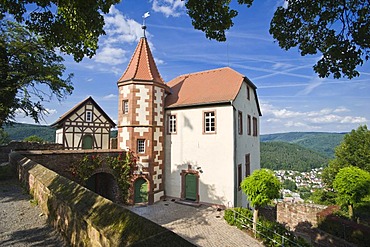
Kommandantenhaus or commander's house, Bergfeste Dilsberg castle, Dilsberg district, Neckargemuend, Naturpark Neckar-Odenwald nature park, Odenwald, Baden-Wuerttemberg, Germany, Europe
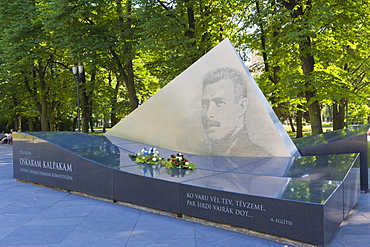
Monument to the first Latvian Army Commander, Oskars Kalpaks, Esplanade, Riga, Latvia, Northern Europe
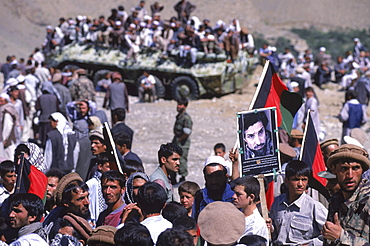
Men, soldiers and schoolboys carry banners and photos to the shrine in the Panjshir Valley of the famous Tajik commander, Ahmad Shah Masood, during a memorial on the one year anniversary of his assasination, September 9, 2002. Masood was a revered mujahedin leader who also was one of the leaders of the Northern Alliance which opposed the Taliban and helped the US Military in their defeat. Masood was assasinated by what are thought to be Al Queda operatives on Sept. 9, 2001. A shrine has been erected in the Panjshir Valley from where he led much of his resistance to both the Soviet and Taliban forces, to honor this latest of Afghan war heros.
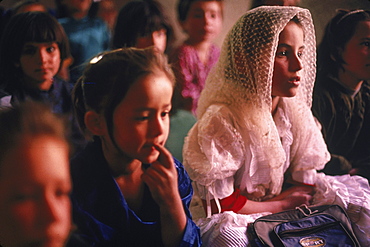
Tajik girls study in a rural school, without windows, desks or chairs, in the Panjshir Valley, Afghanistan. The Panjshir Valley, which was a stronghold for Tajik commander Achmed Shah Masood, was heavily bombed during the Soviet occupation of Afghanistan, but much has now been rebuilt.

Schoolboys chant and carry banners to the shrine in the Panjshir Valley of the famous Tajik commander, Ahmad Shah Masood, on the one year anniversary of his assasination, September 9 2002. Masood was a revered mujahedin leader who also was one of the leaders of the Northern Alliance which opposed the Taliban and helped the US Military in their defeat. Masood was assasinated by what are thought to be Al Queda operatives on Sept. 9, 2001. A shrine has been erected in the Panjshir Valley from where he led much of his resistance to both the Soviet and Taliban forces, to honor this latest of Afghan war heros.
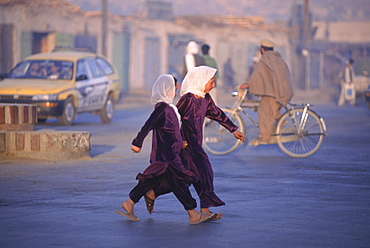
Two school girls hurry across a street at dawn in Kabul, Afghanistan. Since the fall of the Taliban, a record number of girls have returned to school throughout Afghanistan. Much of Kabul was destroyed in the mid 1990's (1992-1996) in factional fighting between rival mujahideen commanders for control of the capital after the Soviet's withdrawal, and now Afghans are re-building their lives and business
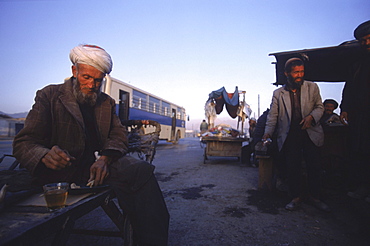
An Afghan man sits on his wooden cart and drinks tea at dawn from a street tea stall in central Kabul. With the first respite from war in nearly two decades, Kabulis are busy re-building their lives and business amongst the ruins, and the streets are busy with markets, tea stalls, trucks, etc. Much of Kabul was destroyed in the mid 1990's (1992-1996) in factional fighting between rival mujahideen commanders for control of the capital after the Soviet's withdrawal.
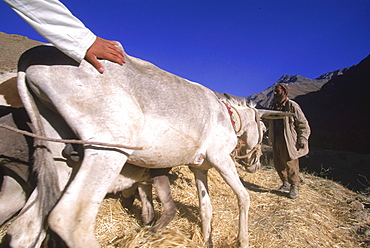
Tajik farmers and their families thresh wheat with oxen and donkeys, in a side valley to the Panjshir Valley, in the Hindu Kush mountains, September 10, 2002. Agriculture is primitive and labor intensive in this remote valley. The Panjshir Valley and its side valleys have long been a stronghold for the Tajik people, and the famous commander Ahmed Shah Masood, in their struggle first against the Soviets and then against the Taliban. The Tajik are one of the larger ethnic groups in Afghanistan, second only to the Pashtun people.

Children play on a tank in the Panjshir Valley while waiting for ceremonies to begin in honor the one year anniversary of the assasination of Ahmad Shah Masood, September 9, 2002. The Panjshir Valley was a stronghold for the Tajik people and the famous commander Masood in their struggle first against the Soviets and then against the Taliban. The valley and villages of the Panjshir were subjected to heavy bombing and destruction during the Afghan-Soviet war, but was never fully occupied. Now it is the heartland for the powerful Tajik ethnic group, the second largest in Afghanistan, who came to partial power after the fall of the Taliban.
